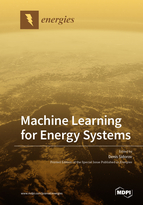Machine Learning for Energy Systems
A special issue of Energies (ISSN 1996-1073). This special issue belongs to the section "F: Electrical Engineering".
Deadline for manuscript submissions: closed (31 July 2020) | Viewed by 45901
Special Issue Editor
Interests: inverse problems; integral equations; machine learning; nonlinear systems; bifurcation; numerical methods; energy systems engineering; optimal design and operation; forecasting; energy storage systems
Special Issues, Collections and Topics in MDPI journals
Special Issue Information
Dear Colleagues,
We are inviting submissions to the Energies Special Issue on “Machine Learning for Energy Systems”.
Future energy systems will grow in complexity, causing both higher demands in reliability and increase in the degrees of freedom for functional improvement of integrated energy systems. Progress in heterogeneous data acquisition, data fusion, and mathematical modeling opens new perspectives in modern energy systems rethinking and improvement. This Special Issue of Energies aims at addressing the top challenges in energy systems development, including electric power systems, heating and cooling systems, and gas transportation systems. Special attention will be given to the efficient mathematical methods integrating data-driven black box dynamical models with classical mathematical and mechanical models and methods.
Original submissions focusing on theoretical and practical issues related to machine learning method theory and applications, including novel optimization and operations research methods and their applications, design techniques and methodologies, reliability analysis, and practical implementation aspects are welcome.
The issue will include but is not be limited to:
- Data-driven energy management strategies and unit commitment problem solvers;
- Multiphysics measurements-based decision making and control of integrated energy systems;
- Energy systems flexibility, efficiency and power quality;
- Uncertainty quantification and inverse problems in energy systems.
Prof. Dr. Denis N. Sidorov
Guest Editor
Manuscript Submission Information
Manuscripts should be submitted online at www.mdpi.com by registering and logging in to this website. Once you are registered, click here to go to the submission form. Manuscripts can be submitted until the deadline. All submissions that pass pre-check are peer-reviewed. Accepted papers will be published continuously in the journal (as soon as accepted) and will be listed together on the special issue website. Research articles, review articles as well as short communications are invited. For planned papers, a title and short abstract (about 100 words) can be sent to the Editorial Office for announcement on this website.
Submitted manuscripts should not have been published previously, nor be under consideration for publication elsewhere (except conference proceedings papers). All manuscripts are thoroughly refereed through a single-blind peer-review process. A guide for authors and other relevant information for submission of manuscripts is available on the Instructions for Authors page. Energies is an international peer-reviewed open access semimonthly journal published by MDPI.
Please visit the Instructions for Authors page before submitting a manuscript. The Article Processing Charge (APC) for publication in this open access journal is 2600 CHF (Swiss Francs). Submitted papers should be well formatted and use good English. Authors may use MDPI's English editing service prior to publication or during author revisions.
Keywords
- optimization
- classification
- optimal design and operation
- energy systems
- forecasting
- multiple criteria decision-making
- uncertainty in design and operation
- operations research
- inverse problems
- clustering






